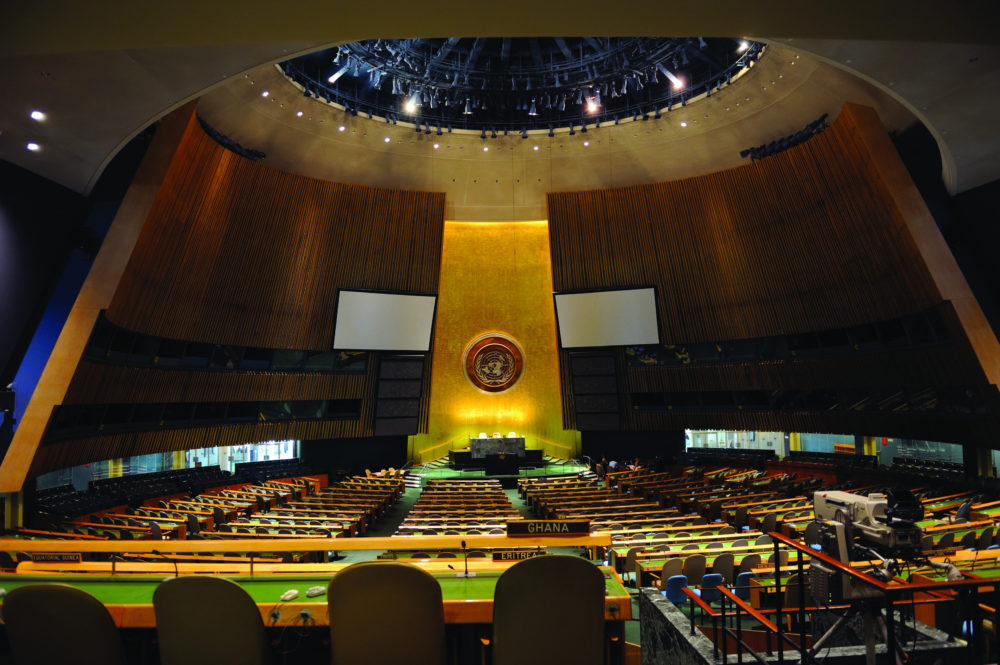 Menu
Menu
 Menu
Menu
International Law and The Non-Proliferation Treaty
At the end of World War II, only three countries—the United States, Great Britain, and Canada—held the secrets of nuclear weapons. And only one country—the U.S.—had actually used them. This monopoly on the bomb did not last for long. In a Cold War effort to show its counterbalance of power, the Soviet Union developed its first nuclear weapon in 1949. The United Kingdom followed suit in 1952. In 1960 France joined the nuclear club, with China next to test a nuclear bomb in 1964. A troubling trend was emerging: a 1963 U.S. Department of Defense report estimated that at least 14 countries could have nuclear weapons by the early 1970s.
This rapid proliferation heightened international concern. The more countries with nuclear weapons, the greater the chances of a conflict escalating into nuclear war either purposefully or by tragic error. Of further concern was that the science behind nuclear technology was becoming public knowledge, especially through academic journals. This even led private companies into the pursuit of nuclear research. A world where every country possessed nuclear weapons was becoming a real possibility, and the bombings of Hiroshima and Nagasaki made the consequences of using nuclear weapons well-known.
There were public programs to prepare citizens for nuclear war, nuclear attack drills in schools, and families building bomb shelters.
All this led to an environment of fear. There were public programs to prepare citizens for nuclear war, nuclear attack drills in schools, and families building bomb shelters. Perhaps ironically, even though people were preparing to survive, their chances of survival were slim. While magazines ran pictures of unscathed families happily carrying on in their fallout shelters, one study out of the RAND Corporation suggested that a 3000-megaton nuclear attack on the United States would leave 80% of the population dead.
It was widely agreed that something had to be done to curtail the growth of nuclear weapons. Proposals to limit or completely ban them began to appear not long after the bomb appeared. However, the world had to wait until 1961 for the first major step towards global disarmament, when Ireland proposed a ban on the distribution of nuclear technology. This proposal laid the groundwork for a 1965 United Nations disarmament conference held in Geneva.

The General Assembly Hall--the largest room in the Manhattan headquarters of the United Nations--seats over 1,800 people.
The conference resulted in the Treaty on the Non-Proliferation of Nuclear Weapons (NPT). First signed in 1968 and put into effect in 1970, the NPT was built on three pillars meant to limit the spread of nuclear weapons and re-frame the use of nuclear technology:
States who signed onto the NPT agreed that they would be subjected to inspections by the International Atomic Energy Agency (IAEA) to ensure compliance with the treaty.
The NPT was meant to last for 25 years, but has been renewed indefinitely by it signatories. Today almost every country in the world has signed on. However, four countries with nuclear weapons have not: India, Israel, and Pakistan have refused to sign, while North Korea has withdrawn from the treaty. It should be noted that Israel has never publically declared it has nuclear weapons, but it is widely-acknowledged that they are in possession of them.
Gauging the success of the NPT—forty-five years into its existence—is complicated. Indeed, the treaty has helped reduce the number of nuclear warheads in the world. There are approximately 17,000 today, compared to a peak of 64,000 in 1986. However, less weapons does not necessarily make us safer. The treaty does not specifically prohibit nuclear-armed signatories from replacing older weapons with newer, more advanced ones. This means that even though there are less nuclear weapons in the world today than any time since 1958, the weapons that do exist are becoming increasingly more powerful. In fact, some modern nuclear weapons are thousands of times more powerful than the bomb used on Hiroshima. Another consideration is the total number of countries with nuclear weapons. While predictions of dozens of nuclear-armed countries did not come true, the number of countries with nuclear arsenals has increased since the NPT was signed. Today, there are nine nuclear-armed states, compared to just six when the treaty came into effect.
As a whole, then, it is perhaps more accurate to say that the Non-Proliferation Treaty has had successes than to say the it has been an overall success. Even with almost every country in the world having signed onto the NPT, global nuclear disarmament is a long way away.
The development of international law is one of the primary goals of the United Nations. According to the U.N., “International Law defines the legal responsibilities of States in their conduct with each other, and their treatment of individuals within state boundaries.” It is meant to build co-operative relationships between states and create minimum standards so that conflict between states can be avoided.
International laws, such as the Non-Proliferation Treaty, are created when the U.N. adopts a particular treaty and opens it for signature and ratification by its member states. Other ways that international laws are created include bilateral treaties between two nations, international customary law which looks to common patterns that have become accepted practice, and generally-accepted principles of law that will be looked to when no other precedent exists. When a signatory to a treaty breaks their responsibilities, the dispute can be resolved by the U.N.’s International Court of Justice.
International Law most often works exceptionally well. However, it is not without problems. For example, unlike the laws of Canada which all Canadians and the government itself are obliged to follow, international law could be seen as a voluntary system. This is because only the countries that sign onto international treaties are obliged to follow those treaties. However, the main benefit of international law is that it creates a global framework that is generally understood and generally agreed-upon by all nations.